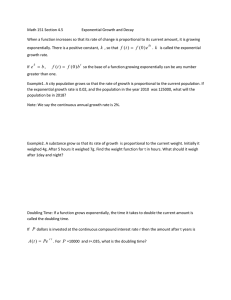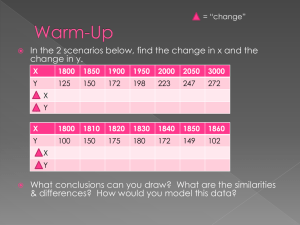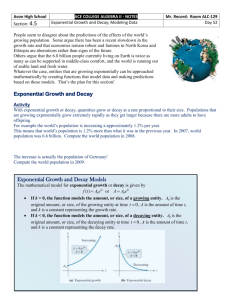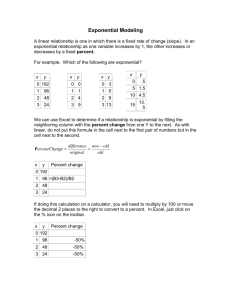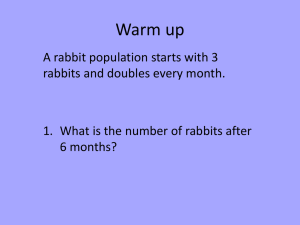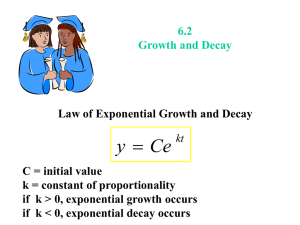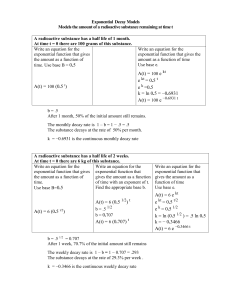Growth
advertisement
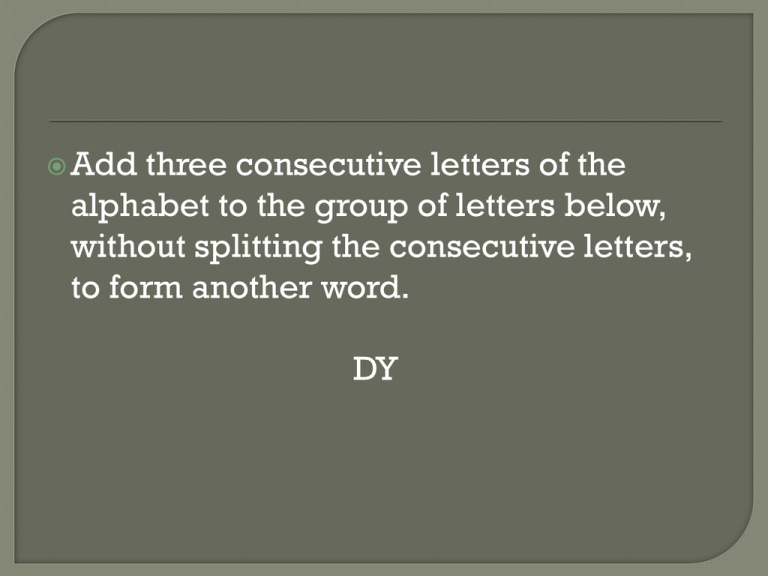
Add three consecutive letters of the alphabet to the group of letters below, without splitting the consecutive letters, to form another word. DY STUDY Which month comes next? January, March, June, October, March, ? September All widgets are green. Everything green has a hole in the middle. Some things that are green have a jagged edge. Therefore: 1. All widgets have a hole in the middle 2. Everything with a jagged edge is a widget. 3. Neither of the above is true. 4. Both the above are true. 1. All widgets have a hole in the middle Week 2 Your sister is selling Girl Scout cookies for $2.60 a box. She’s already made $15.60. Write an equation for the situation above: • y = 2.60x + 15.60 How much does she make after selling 10 more boxes? • y = 2.60 (10) + 15.60 = $41.60 How many boxes does she have to sell to make $130? (y = 2.60x + 15.60) • 130 = 2.60x + 15.60 • (subtract 15.60 from both sides) • 114.40 = 2.6x • (divide both sides by 2.6) • x = 44 y=5x-9 Solve for y • y = 5(2)-9 • y=1 when x = 2. Solve for x when y = 6. • 6 = 5x – 9 (next: add 9 to both sides) • 15 = 5x (next: divide both sides by 5) • x=3 We learned about linear modeling. • Model: y = mx +b • Graph: straight line Exponential Modeling x is an exponent. EXPONENTIAL GROWTH Model: y = a(1+r)x y: final a: initial r: rate x: time EXPONENTIAL DECAY Model: y = a(1-r)x y: final a: initial r: rate x: time Graph: Populations tend to growth exponentially not linearly When an object cools (e.g., a pot of soup), the temperature decreases exponentially toward the ambient temperature (the surrounding temperature) Radioactive substances decay exponentially Bacteria populations grow exponentially Money in a savings account with at a fixed rate of interest increases exponentially Viruses and even rumors tend to spread exponentially through a population (at first) Anything that doubles, triples, halves over a certain amount of time Anything that increases or decreases by a percent Difference: • Linear: Constant Rate of Change • Exponential: Constant Percent Change How can you tell? • Linear, if it increases by the same or decreases by the same • Exponential, calculate the percent change and see if it stays constant Percent change = (changed- reference)/reference exponential growth? The percent change is 20% each time. So it is an exponential function. Two bosses • A: one million dollars for one month • B: a penny doubled every day for a month Who would you work for? Boss B • Day 1: $.02 • Day 2: $.04 • Day 3: $.08 • … • Day 10: $10.24 • … • Day 20: $10,485.76 Change of mind? Calculations • y = a (1+r)x • y = .01 (1+1)30 • y = 10,737,418.24 Growth (savings account) • y = a(1+r)x Decay (radioisotope dating) • y = a(1-r) x If roaches grow at a rate of 25% every 10 days, how long will it take 400 roaches to become 1000 in number? Drag it down • Right click on the + at the right bottom • Move down with the mouse A little bit after 40 days Dead Sea Scrolls have about 78% of the normally occurring amount of Carbon 14 in them. Carbon 14 decays at a rate of about 1.202% per 100 years. How old are the Dead Sea Scrolls? Since we know the rate of decay per every 100 years, make the excel table have intervals of 100 years. (after entering 0 and 100, you can select the two and drag down) Answer: between 2000 to 2100 years old Activity 2, 3 Homework 2



